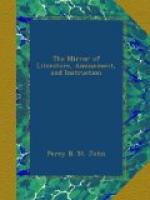In 1659, the Commons resolved that Somerset House, with all its appurtenances, should be sold for the partial discharge of the great arrears due to the army; and Ludlow states, that it was sold for 10,000l. except the chapel; but the restoration of King Charles prevented the agreement from being fulfilled.
This mansion was frequently used for the state reception of the remains of deceased persons of high rank previously to their interment. The Protector, Oliver Cromwell, was laid in state here; and Ludlow states, that the folly and profusion of this display so provoked the people, that they “threw dirt, in the night, on his escutcheon, that was placed over the great gate of Somerset House.” After the restoration of Charles II. Somerset House reverted to the queen dowager, who returned to England in 1660; went back to France, but returning in 1662, she took up her residence at Somerset House; when Cowley and Waller wrote some courtly verses in honour of this edifice, the latter complimenting the queen with Somerset House rising at her command, “like the first creation.”
In 1670, the remains of Monck, Duke of Albemarle, were laid here “for many weeks in royal state.” For several years subsequently to this period the mansion was but little occupied; but in 1677, the Prince of Orange, afterwards William III., resided here for a short period prior to his marriage. In 1678, Somerset House became the reputed, if not the real scene of the mysterious murder of Sir Edmund Berry Godfrey, which is attributed to the Papists connected with the chapel establishment of Catherine of Braganza, queen of Charles II.; to whom this mansion was destined, contingently, as a jointure-house, and who was occasionally lodged here when Charles’s gallantries had rendered it incompatible for her to be at Whitehall. On the king’s decease, in 1685, she removed hither entirely, and kept her court here till 1692, when she departed for Portugal, leaving her palace to the Earl of Faversham, who continued to inhabit it till after the decease of the queen dowager in 1705.
From a description about 1720, we learn that “the stately piles of new brick houses on both sides of Somerset House, much eclipse that palace.” At the entrance from the Strand, “is a spacious square court, garnished on all sides with rows of freestone buildings, and at the front is a piazza, with stone pillars, and a pavement of freestone. Besides this court there are other larger ones, which are descended towards the river by spacious stairs of freestone. The outward beauty of this court appears by a view from the water, having a good front, and a most pleasant garden, which runs to the water side. More westward is a large yard adjoining to the Savoy, made use of for a coach-house and stables; at the bottom of which are stairs, much used by watermen, this being a noted place for landing and taking water at.” The water gate was ornamented with the figures of Thames and Isis, and in the centre of the water-garden was a statue. The principal garden was a kind of raised terrace, (ascended by steps from the water side) in which there was a large basin, once dignified with a fountain. The ground was laid out in parterres, near the angles of which statues were placed; one of them, a Mercury, in brass, had been appraised, in 1649, at 500l.




